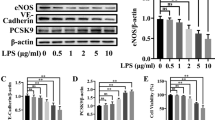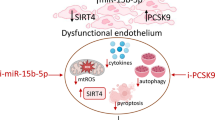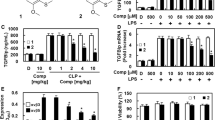Abstract
The activation of the angiopoietin (Angpt)-Tie system is linked to endothelial dysfunction during sepsis. Bacterial quorum-sensing molecules function as pathogen-associated molecular patterns. However, their impact on the endothelium and the Angpt-Tie system remains unclear. Therefore, this study investigated whether treatment with N-3-oxododecanoyl homoserine lactone (3OC12-HSL), a quorum-sensing molecule derived from Pseudomonas aeruginosa, impaired endothelial function in human umbilical vein endothelial cells. 3OC12-HSL treatment impaired tube formation even at sublethal concentrations, and immunocytochemistry analysis revealed that it seemed to reduce vascular endothelial-cadherin expression at the cell−cell interface. Upon assessing the mRNA expression patterns of genes associated with the Angpt-Tie axis, the expressions of Angpt2, Forkhead box protein O1, Tie1, and vascular endothelial growth factor 2 were found to be upregulated in the 3OC12-HSL-treated cells. Moreover, western blot analysis revealed that 3OC12-HSL treatment increased Angpt2 expression. A co-immunoprecipitation assay was conducted to assess the effect of 3OC12-HSL on the IQ motif containing GTPase activating protein 1 (IQGAP1) and Rac1 complex and the interaction between these proteins was consistently maintained regardless of 3OC12-HSL treatment. Next, recombinant human (rh)-Angpt1 was added to assess whether it modulated the effects of 3OC12-HSL treatment. rh-Angpt1 addition increased cellular viability, improved endothelial function, and reversed the overall patterns of mRNA and protein expression in endothelial cells treated with 3OC12-HSL. Additionally, it was related to the increased expression of phospho-Akt and the IQGAP1 and Rac1 complex. Collectively, our findings indicated that 3OC12-HSL from Pseudomonas aeruginosa can impair endothelial integrity via the activation of the Angpt-Tie axis, which appeared to be reversed by rh-Angpt1 treatment.






Similar content being viewed by others
Data Availability
No datasets were generated or analyzed during the current study.
References
Singer, M., Deutschman, C. S., & Seymour, C. W., et al. (2016). The Third International Consensus Definitions for Sepsis and Septic Shock (Sepsis-3). JAMA, 315(8), 801–810. https://doi.org/10.1001/jama.2016.0287.
Blanco, J., Muriel-Bombin, A., & Sagredo, V., et al. (2008). Incidence, organ dysfunction and mortality in severe sepsis: a Spanish multicentre study. Critical Care, 12(6), R158 https://doi.org/10.1186/cc7157.
Sakr, Y., Lobo, S. M., & Moreno, R. P., et al. (2012). Patterns and early evolution of organ failure in the intensive care unit and their relation to outcome. Critical Care, 16(6), R222. https://doi.org/10.1186/cc11868.
Ince, C., Mayeux, P. R., & Nguyen, T., et al. (2016). The endothelium in Sepsis. Shock, 45(3), 259–270. https://doi.org/10.1097/SHK.0000000000000473.
Lelubre, C., & Vincent, J. L. (2018). Mechanisms and treatment of organ failure in sepsis. Nature Reviews Nephrology, 14(7), 417–427. https://doi.org/10.1038/s41581-018-0005-7.
Koh, G. Y. (2013). Orchestral actions of angiopoietin-1 in vascular regeneration. Trends in Molecular Medicine, 19(1), 31–39. https://doi.org/10.1016/j.molmed.2012.10.010.
Kim, I., Kim, H. G., So, J. N., Kim, J. H., Kwak, H. J., & Koh, G. Y. (2000). Angiopoietin-1 regulates endothelial cell survival through the phosphatidylinositol 3’-Kinase/Akt signal transduction pathway. Circulation Research, 86(1), 24–29. https://doi.org/10.1161/01.res.86.1.24.
Kontos, C. D., Cha, E. H., York, J. D., & Peters, K. G. (2002). The endothelial receptor tyrosine kinase Tie1 activates phosphatidylinositol 3-kinase and Akt to inhibit apoptosis. Molecular and Cellular Biology, 22(6), 1704–1713. https://doi.org/10.1128/MCB.22.6.1704-1713.2002.
Daly, C., Wong, V., & Burova, E., et al. (2004). Angiopoietin-1 modulates endothelial cell function and gene expression via the transcription factor FKHR (FOXO1). Genes Development, 18(9), 1060–1071. https://doi.org/10.1101/gad.1189704.
Gavard, J., Patel, V., & Gutkind, J. S. (2008). Angiopoietin-1 prevents VEGF-induced endothelial permeability by sequestering Src through mDia. Developmental Cells, 14(1), 25–36. https://doi.org/10.1016/j.devcel.2007.10.019.
Maisonpierre, P. C., Suri, C., & Jones, P. F., et al. (1997). Angiopoietin-2, a natural antagonist for Tie2 that disrupts in vivo angiogenesis. Science, 277(5322), 55–60. https://doi.org/10.1126/science.277.5322.55.
Saharinen, P., Eklund, L., & Alitalo, K. (2017). Therapeutic targeting of the angiopoietin-TIE pathway. Nature Reviews Drug Discovery, 16(9), 635–661. https://doi.org/10.1038/nrd.2016.278.
Parikh, S. M., Mammoto, T., & Schultz, A., et al. (2006). Excess circulating angiopoietin-2 may contribute to pulmonary vascular leak in sepsis in humans. PLoS Medicine, 3(3), e46. https://doi.org/10.1371/journal.pmed.0030046.
David, S., Mukherjee, A., & Ghosh, C. C., et al. (2012). Angiopoietin-2 may contribute to multiple organ dysfunction and death in sepsis. Critical Care Medicine, 40(11), 3034–3041. https://doi.org/10.1097/CCM.0b013e31825fdc31.
Lymperopoulou, K., Velissaris, D., & Kotsaki, A., et al. (2015). Angiopoietin-2 associations with the underlying infection and sepsis severity. Cytokine, 73(1), 163–168. https://doi.org/10.1016/j.cyto.2015.01.022.
Fang, Y., Li, C., Shao, R., Yu, H., Zhang, Q., & Zhao, L. (2015). Prognostic significance of the angiopoietin-2/angiopoietin-1 and angiopoietin-1/Tie-2 ratios for early sepsis in an emergency department. Critical Care, 19, 367. https://doi.org/10.1186/s13054-015-1075-6.
Hughes, D. T., & Sperandio, V. (2008). Inter-kingdom signalling: communication between bacteria and their hosts. Nature Reviews Microbiology, 6(2), 111–120. https://doi.org/10.1038/nrmicro1836.
Whiteley, M., Diggle, S. P., & Greenberg, E. P. (2017). Progress in and promise of bacterial quorum sensing research. Nature, 551(7680), 313–320. https://doi.org/10.1038/nature24624.
Shiner, E. K., Terentyev, D., & Bryan, A., et al. (2006). Pseudomonas aeruginosa autoinducer modulates host cell responses through calcium signalling. Cellular Microbiology, 8(10), 1601–1610. https://doi.org/10.1111/j.1462-5822.2006.00734.x.
Skindersoe, M. E., Zeuthen, L. H., & Brix, S., et al. (2009). Pseudomonas aeruginosa quorum-sensing signal molecules interfere with dendritic cell-induced T-cell proliferation. FEMS Immunology and Medical Microbiology, 55(3), 335–345. https://doi.org/10.1111/j.1574-695X.2008.00533.x.
Vikstrom, E., Bui, L., Konradsson, P., & Magnusson, K. E. (2010). Role of calcium signalling and phosphorylations in disruption of the epithelial junctions by Pseudomonas aeruginosa quorum sensing molecule. European Journal of Cell Biology, 89(8), 584–597. https://doi.org/10.1016/j.ejcb.2010.03.002.
Karlsson, T., Turkina, M. V., Yakymenko, O., Magnusson, K. E., & Vikstrom, E. (2012). The Pseudomonas aeruginosa N-acylhomoserine lactone quorum sensing molecules target IQGAP1 and modulate epithelial cell migration. PLoS Pathogens, 8(10), e1002953. https://doi.org/10.1371/journal.ppat.1002953.
Schwarzer, C., Fu, Z., & Patanwala, M., et al. (2012). Pseudomonas aeruginosa biofilm-associated homoserine lactone C12 rapidly activates apoptosis in airway epithelia. Cellular Microbiology, 14(5), 698–709. https://doi.org/10.1111/j.1462-5822.2012.01753.x.
Glucksam-Galnoy, Y., Sananes, R., & Silberstein, N., et al. (2013). The bacterial quorum-sensing signal molecule N-3-oxo-dodecanoyl-L-homoserine lactone reciprocally modulates pro- and anti-inflammatory cytokines in activated macrophages. Journal of Immunology, 191(1), 337–344. https://doi.org/10.4049/jimmunol.1300368.
Song, D., Meng, J., & Cheng, J., et al. (2019). Pseudomonas aeruginosa quorum-sensing metabolite induces host immune cell death through cell surface lipid domain dissolution. Nature Microbiology, 4(1), 97–111. https://doi.org/10.1038/s41564-018-0290-8.
Shin, J., Ahn, S. H., Kim, S. H., & Oh, D. J. (2021). N-3-oxododecanoyl homoserine lactone exacerbates endothelial cell death by inducing receptor-interacting protein kinase 1-dependent apoptosis. American Journal of Physiology-Cell Physiology, 321(4), C644–C653. https://doi.org/10.1152/ajpcell.00094.2021.
Brindle, N. P., Saharinen, P., & Alitalo, K. (2006). Signaling and functions of angiopoietin-1 in vascular protection. Circulation Research, 98(8), 1014–1023. https://doi.org/10.1161/01.RES.0000218275.54089.12.
Smith, R. S., Harris, S. G., Phipps, R., & Iglewski, B. (2002). The Pseudomonas aeruginosa quorum-sensing molecule N-(3-oxododecanoyl)homoserine lactone contributes to virulence and induces inflammation in vivo. Journal of Bacteriology, 184(4), 1132–1139. https://doi.org/10.1128/jb.184.4.1132-1139.2002.
Vincent, J. L., Sakr, Y., & Sprung, C. L., et al. (2006). Sepsis in European intensive care units: results of the SOAP study. Critical Care Medicine, 34(2), 344–353. https://doi.org/10.1097/01.ccm.0000194725.48928.3a.
Blomquist, K. C., & Nix, D. E. (2021). A critical evaluation of newer beta-lactam antibiotics for treatment of Pseudomonas aeruginosa Infections. Annals of Pharmacotherapy, 55(8), 1010–1024. https://doi.org/10.1177/1060028020974003.
Menden, H., Welak, S., Cossette, S., Ramchandran, R., & Sampath, V. (2015). Lipopolysaccharide (LPS)-mediated angiopoietin-2-dependent autocrine angiogenesis is regulated by NADPH oxidase 2 (Nox2) in human pulmonary microvascular endothelial cells. Journal of Biological Chemistry, 290(9), 5449–5461. https://doi.org/10.1074/jbc.M114.600692.
Simons, M., Gordon, E., & Claesson-Welsh, L. (2016). Mechanisms and regulation of endothelial VEGF receptor signalling. Nature Reviews Molecular Cell Biology, 17(10), 611–625. https://doi.org/10.1038/nrm.2016.87.
Kawai, T., & Akira, S. (2007). Signaling to NF-kappaB by Toll-like receptors. Trends in Molecular Medicine, 13(11), 460–469. https://doi.org/10.1016/j.molmed.2007.09.002.
Ding, J., Song, D., Ye, X., & Liu, S. F. (2009). A pivotal role of endothelial-specific NF-kappaB signaling in the pathogenesis of septic shock and septic vascular dysfunction. Journal of Immunology, 183(6), 4031–4038. https://doi.org/10.4049/jimmunol.0900105.
Kravchenko, V. V., Kaufmann, G. F., & Mathison, J. C., et al. (2006). N-(3-oxo-acyl)homoserine lactones signal cell activation through a mechanism distinct from the canonical pathogen-associated molecular pattern recognition receptor pathways. Journal of Biological Chemistry, 281(39), 28822–28830. https://doi.org/10.1074/jbc.M606613200.
Kravchenko, V. V., Kaufmann, G. F., & Mathison, J. C., et al. (2008). Modulation of gene expression via disruption of NF-kappaB signaling by a bacterial small molecule. Science, 321(5886), 259–263. https://doi.org/10.1126/science.1156499.
Vikstrom, E., Bui, L., Konradsson, P., & Magnusson, K. E. (2009). The junctional integrity of epithelial cells is modulated by Pseudomonas aeruginosa quorum sensing molecule through phosphorylation-dependent mechanisms. Experimental Cell Research, 315(2), 313–326. https://doi.org/10.1016/j.yexcr.2008.10.044.
Watanabe, T., Wang, S., & Noritake, J., et al. (2004). Interaction with IQGAP1 links APC to Rac1, Cdc42, and actin filaments during cell polarization and migration. Developmental Cells, 7(6), 871–883. https://doi.org/10.1016/j.devcel.2004.10.017.
Noritake, J., Fukata, M., & Sato, K., et al. (2004). Positive role of IQGAP1, an effector of Rac1, in actin-meshwork formation at sites of cell-cell contact. Molecular Biology of the Cell, 15(3), 1065–1076. https://doi.org/10.1091/mbc.e03-08-0582.
Mataraza, J. M., Briggs, M. W., Li, Z., Entwistle, A., Ridley, A. J., & Sacks, D. B. (2003). IQGAP1 promotes cell motility and invasion. Journal of Biological Chemistry, 278(42), 41237–41245. https://doi.org/10.1074/jbc.M304838200.
David, S., Ghosh, C. C., Mukherjee, A., & Parikh, S. M. (2011). Angiopoietin-1 requires IQ domain GTPase-activating protein 1 to activate Rac1 and promote endothelial barrier defense. Arteriosclerosis, Thrombosis, and Vascular Biology, 31(11), 2643–2652. https://doi.org/10.1161/ATVBAHA.111.233189.
Korhonen, E. A., Lampinen, A., & Giri, H., et al. (2016). Tie1 controls angiopoietin function in vascular remodeling and inflammation. Journal of Clinical Investigation, 126(9), 3495–3510. https://doi.org/10.1172/JCI84923.
Cho, C. H., Kim, K. E., & Byun, J., et al. (2005). Long-term and sustained COMP-Ang1 induces long-lasting vascular enlargement and enhanced blood flow. Circulation Research, 97(1), 86–94. https://doi.org/10.1161/01.RES.0000174093.64855.a6.
David, S., Park, J. K., & Meurs, M., et al. (2011). Acute administration of recombinant Angiopoietin-1 ameliorates multiple-organ dysfunction syndrome and improves survival in murine sepsis. Cytokine, 55(2), 251–259. https://doi.org/10.1016/j.cyto.2011.04.005.
Acknowledgements
This work was supported by the National Research Foundation of Korea grant funded by the Korean government (MSIP) (No. 2020R1F1A1072498) and by departmental funding granted by Ma’am Sangchun Jung.
Author information
Authors and Affiliations
Contributions
Conceptualization, J.S. and D.J.O.; methodology, J.S., S.H.A., and D.J.O.; formal analysis and investigation, J.S. and S.H.A.; writing—original draft preparation, J.S. and D.J.O. All authors have read and agreed to the final version of the manuscript.
Corresponding author
Ethics declarations
Conflict of Interest
The authors declare no competing interests.
Additional information
Publisher’s note Springer Nature remains neutral with regard to jurisdictional claims in published maps and institutional affiliations.
Rights and permissions
Springer Nature or its licensor (e.g. a society or other partner) holds exclusive rights to this article under a publishing agreement with the author(s) or other rightsholder(s); author self-archiving of the accepted manuscript version of this article is solely governed by the terms of such publishing agreement and applicable law.
About this article
Cite this article
Shin, J., Ahn, S.H. & Oh, DJ. Pseudomonas aeruginosa N-3-Oxododecanoyl Homoserine Lactone Disrupts Endothelial Integrity by Activating the Angiopoietin-Tie System. Cell Biochem Biophys (2024). https://doi.org/10.1007/s12013-024-01307-8
Accepted:
Published:
DOI: https://doi.org/10.1007/s12013-024-01307-8




